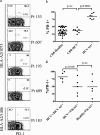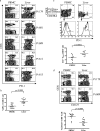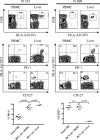Liver-infiltrating lymphocytes in chronic human hepatitis C virus infection display an exhausted phenotype with high levels of PD-1 and low levels of CD127 expression
- PMID: 17182670
- PMCID: PMC1865979
- DOI: 10.1128/JVI.02021-06
Liver-infiltrating lymphocytes in chronic human hepatitis C virus infection display an exhausted phenotype with high levels of PD-1 and low levels of CD127 expression
Abstract
The majority of people infected with hepatitis C virus (HCV) fail to generate or maintain a T-cell response effective for viral clearance. Evidence from murine chronic viral infections shows that expression of the coinhibitory molecule PD-1 predicts CD8+ antiviral T-cell exhaustion and may contribute to inadequate pathogen control. To investigate whether human CD8+ T cells express PD-1 and demonstrate a dysfunctional phenotype during chronic HCV infection, peripheral and intrahepatic HCV-specific CD8+ T cells were examined. We found that in chronic HCV infection, peripheral HCV-specific T cells express high levels of PD-1 and that blockade of the PD-1/PD-L1 interaction led to an enhanced proliferative capacity. Importantly, intrahepatic HCV-specific T cells, in contrast to those in the periphery, express not only high levels of PD-1 but also decreased interleukin-7 receptor alpha (CD127), an exhausted phenotype that was HCV antigen specific and compartmentalized to the liver, the site of viral replication.
Figures




Comment in
-
Access to liver transplantation: still a controversial issue.Liver Transpl. 2007 Sep;13(9):1340-1. Liver Transpl. 2007. PMID: 17924513 No abstract available.
-
Evasive nature of the hepatitis C virus.Liver Transpl. 2007 Sep;13(9):1342. Liver Transpl. 2007. PMID: 17924517 No abstract available.
References
-
- Alter, M. J., D. Kruszon-Moran, O. V. Nainan, G. M. McQuillan, F. Gao, L. A. Moyer, R. A. Kaslow, and H. S. Margolis. 1999. The prevalence of hepatitis C virus infection in the United States, 1988 through 1994. N. Engl. J. Med. 341:556-562. - PubMed
-
- Alter, M. J., H. S. Margolis, K. Krawczynski, F. N. Judson, A. Mares, W. J. Alexander, P. Y. Hu, J. K. Miller, M. A. Gerber, R. E. Sampliner, et al. 1992. The natural history of community-acquired hepatitis C in the United States. N. Engl. J. Med. 327:1899-1905. - PubMed
-
- Appay, V., P. R. Dunbar, M. Callan, P. Klenerman, G. M. Gillespie, L. Papagno, G. S. Ogg, A. King, F. Lechner, C. A. Spina, S. Little, D. V. Havlir, D. D. Richman, N. Gruener, G. Pape, A. Waters, P. Easterbrook, M. Salio, V. Cerundolo, A. J. McMichael, and S. L. Rowland-Jones. 2002. Memory CD8+ T cells vary in differentiation phenotype in different persistent virus infections. Nat. Med. 8:379-385. - PubMed
-
- Bachmann, M. F., P. Wolint, K. Schwarz, P. Jager, and A. Oxenius. 2005. Functional properties and lineage relationship of CD8+ T cell subsets identified by expression of IL-7 receptor alpha and CD62L. J. Immunol. 175:4686-4696. - PubMed
-
- Barber, D. L., E. J. Wherry, D. Masopust, B. Zhu, J. P. Allison, A. H. Sharpe, G. J. Freeman, and R. Ahmed. 2006. Restoring function in exhausted CD8 T cells during chronic viral infection. Nature 439:682-687. - PubMed
Publication types
MeSH terms
Substances
Grants and funding
LinkOut - more resources
Full Text Sources
Other Literature Sources
Molecular Biology Databases
Research Materials

